Table Of ContentThe Turing Guide
THE TURING GUIDE
b. jack copeland
jonathan p. bowen
mark sprevak
robin wilson
and others
1
3
Great Clarendon Street, Oxford, OX2 6DP,
United Kingdom
Oxford University Press is a department of the University of Oxford.
It furthers the University’s objective of excellence in research, scholarship,
and education by publishing worldwide. Oxford is a registered trade mark of
Oxford University Press in the UK and in certain other countries
© Oxford University Press 2017
he moral rights of the authors have been asserted
First Edition published in 2017
Impression: 1
All rights reserved. No part of this publication may be reproduced, stored in
a retrieval system, or transmitted, in any form or by any means, without the
prior permission in writing of Oxford University Press, or as expressly permitted
by law, by licence or under terms agreed with the appropriate reprographics
rights organization. Enquiries concerning reproduction outside the scope of the
above should be sent to the Rights Department, Oxford University Press, at the
address above
You must not circulate this work in any other form
and you must impose this same condition on any acquirer
Published in the United States of America by Oxford University Press
198 Madison Avenue, New York, NY 10016, United States of America
British Library Cataloguing in Publication Data
Data available
Library of Congress Control Number: 2016946810
ISBN 978–0–19–874782–6 (hbk.)
ISBN 978–0–19–874783–3 (pbk.)
Printed and bound by
CPI Group (UK) Ltd, Croydon, CR0 4YY
Links to third party websites are provided by Oxford in good faith and
for information only. Oxford disclaims any responsibility for the materials
contained in any third party website referenced in this work.
In memoriam
MAVIS BATEY (1921–2013)
CATHERINE CAUGHEY (1923–2008)
IVOR GRATTAN-GUINNESS (1941–2014)
PETER HILTON (1923–2010)
JERRY ROBERTS (1920–2014)
FOREWORD BY ANDREW HODGES
Author of the bestseller Alan Turing, the Enigma
his book celebrates Alan Turing’s place in mathematics, science, technology, and philosophy,
and includes chapters by a number of Turing’s contemporaries. A glance at its pages will show
the diversity of the contributions. Some are fastidious scholarship, bringing to life details of
smudged typescripts and incomplete manuscripts from over 60 years ago. Some convey mod-
ern scientiic developments. Some explore personal memories, or philosophical speculations.
But they share a special concern to shed new light on hidden history.
Turing’s centenary year relected a general public sense that the issues of Alan Turing’s life
and work are as relevant as ever in the twenty-irst century. One reason is obvious: the univer-
sality of the computer has invaded everyday consciousness. It has changed the relationship
between the individual and the social world. he computer has made possible impassioned
public campaigns for Turing’s oicial recognition, demanding some remedy for his identity
as a criminalized gay man. At the same time, the signiicance of the modern state’s computer-
based collection and analysis of information, of which he was the scientiic founder, has made
a new impact on the world political arena. Turing himself knew that the computer would
involve everything: it was preigured in his futuristic discussion of the meaning of mechanical
intelligence, where his all-embracing discourse touched provocatively on topics from sex to
cryptography.
Andrew Hodges
Mathematical Institute, University of Oxford
PREFACE
T
his book celebrates the many facets of Alan Turing, the British mathematician and com-
puting pioneer who is widely considered to be the father of computer science. he book
is written for general readers, and Turing’s scientiic and mathematical concepts are
explained in an accessible way.
Each of the book’s eight parts covers a diferent aspect of Turing’s life and work. Part I is
biographical: Chapter 1 contains a timeline of Turing’s short but brilliant life, Chapter 2 is an
appraisal by family member Dermot Turing, and Chapter 3, by Turing’s close colleague and
friend Peter Hilton, describes what it was like to work with a genius like Alan Turing, while
Chapter 4 focuses on his trial—for being gay—and his shocking punishment. Part II deals with
the early origins of the computer, and focuses in particular on Turing’s ‘universal computing
machine’, now known as the universal Turing machine. Part III explains exactly what Turing
did as a codebreaker at Bletchley Park during the Second World War. he war was a disastrous
interlude for many, but for Turing it provided an internationally important outlet for his crea-
tive genius. It is no overstatement to say that, without Turing, the war would probably have
lasted longer, and might even have been won by the Nazis. he ultrasecret nature of Turing’s
wartime work meant that much of what he did was kept secret until recent times. Some remains
classiied to this day.
When the war was over, Turing let Bletchley Park and joined London’s National Physical
Laboratory. Part IV is about his post-war work on computing, irst in London and then in
Manchester: Turing had his own quirky but highly efective approach to designing hardware
and sotware. Part V discusses artiicial intelligence (AI), called ‘machine intelligence’ by Turing.
He was AI’s irst major prophet and contributed a slew of brilliant concepts to the ield that he
founded. Part VI goes on to explain Turing’s theory of morphogenesis, his inal scientiic con-
tribution. his theory tries to unlock the secret of how shapes—such as the shape of a starish or
a daisy—are formed during biological growth. Turing’s brilliant 1952 paper on morphogenesis
made his reputation as a mathematical biologist, and was also the starting point of the modern
ield called ‘artiicial life’. Part VII describes some of Turing’s contributions to pure and applied
mathematics, including his ‘Banburismus’ method, used against the German Enigma code, and
his work on the Entscheidungsproblem or ‘decision problem’, which gave rise to his universal
computing machine. Part VIII is, as its title says, a inale: its topics range from speculations
about the nature of the universe to a discussion of recent plays, novels, and music about Turing.

